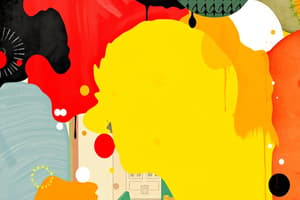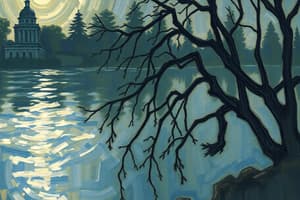Podcast
Questions and Answers
What are the Visual Elements?
What are the Visual Elements?
They are the elements that we perceive and respond to when we look at a work's form: line, shape, mass, light, color, texture, pattern, and space.
What is a line?
What is a line?
A line is a path traced by a moving point.
What is a shape?
What is a shape?
A two-dimensional area having identifiable boundaries, created by lines, color or value changes.
What is mass?
What is mass?
What is the figure in two-dimensional images?
What is the figure in two-dimensional images?
What are positive shapes?
What are positive shapes?
What are negative shapes?
What are negative shapes?
What is ground in art?
What is ground in art?
What is hatching?
What is hatching?
What is cross-hatching?
What is cross-hatching?
What is stippling?
What is stippling?
What is refraction?
What is refraction?
Who can be traced back to our present-day color theory?
Who can be traced back to our present-day color theory?
What experiment did Newton conduct with light in 1666?
What experiment did Newton conduct with light in 1666?
What did Newton's Color Prism Experiment of 1666 prove?
What did Newton's Color Prism Experiment of 1666 prove?
What are the separated colors of Newton's prism?
What are the separated colors of Newton's prism?
What is a color wheel?
What is a color wheel?
What are primary colors?
What are primary colors?
What are secondary colors?
What are secondary colors?
What are intermediate colors?
What are intermediate colors?
What are warm colors?
What are warm colors?
What are cool colors?
What are cool colors?
What is hue?
What is hue?
What is value in art?
What is value in art?
What is a tint?
What is a tint?
What is a shade?
What is a shade?
What is intensity in art?
What is intensity in art?
What does monochromatic mean?
What does monochromatic mean?
What are complementary colors?
What are complementary colors?
Flashcards are hidden until you start studying
Study Notes
Visual Elements
- Visual elements are components that influence perception and response in art, including line, shape, mass, light, color, texture, pattern, and space.
Line
- Defined as a path traced by a moving point, essential in creating forms and shapes in art.
Shape
- Refers to a two-dimensional area with identifiable boundaries, formed by lines or changes in color and value.
Mass
- Describes a three-dimensional form, suggesting bulk, density, and weight.
Figure and Ground
- Figure refers to the dominant shape in an artwork, while ground is the background against which the figure is perceived.
- Positive shapes indicate figure shapes, and negative shapes denote ground shapes.
Ground
- This term can also refer to a preparatory paint coating applied to supports for drawings or paintings, or an acid-resistant coating used for etching plates.
Hatching
- Involves using closely spaced parallel lines that mix optically to suggest values, commonly related to chiaroscuro techniques.
Cross-Hatching
- Involves superimposing layers of hatching at angles to achieve darker values and increased depth.
Stippling
- A technique using closely spaced dots to create a three-dimensional effect on flat surfaces, prevalent in drawing and printmaking.
Refraction
- The bending of light rays when passing through a prism, illustrating light's behavior.
Color Theory Origins
- Modern color theory traces back to Sir Isaac Newton's studies in the 17th century.
Newton's Color Experiment
- In 1666, Newton conducted an experiment where he passed sunlight through a prism, discovering that it could recombine rainbow colors into white light, proving colors are components of light.
Colors from Newton's Prism
- The separated colors include red, orange, yellow, green, blue, and violet, plus the transitional color red-violet.
Color Wheel
- A circular arrangement of colors used to demonstrate color theory, incorporating spectral hues and red-violet.
Primary Colors
- Consisting of red, yellow, and blue, primary colors cannot be created by mixing other colors.
Secondary Colors
- Comprised of orange, green, and violet, these are made by mixing two primary colors.
Intermediate Colors
- Also called tertiary colors, formed by combining a primary color with an adjacent secondary color (e.g., yellow-green).
Warm Colors
- Colors like red to yellow found along the orange curve of the color wheel, typically evoking warmth.
Cool Colors
- Colors ranging from green to violet along the blue curve of the color wheel, often associated with coolness.
Hue
- Represents the name of a color in relation to the color wheel, specifying categories like green, red, or blue-violet.
Value
- Refers to the relative lightness or darkness of a hue, ranging from white to black.
Tint
- A lighter variation of a hue, where adding white results in colors like pink as a tint of red.
Shade
- A darker variation of a hue achieved by adding black, exemplified by maroon as a shade of red.
Intensity
- Indicates the purity or brightness of a color, also known as chroma or saturation.
Monochromatic
- Describes works that utilize only one color with variations in value and intensity.
Complementary Colors
- Hues that enhance each other's intensity when placed side by side, creating visual interest.
Studying That Suits You
Use AI to generate personalized quizzes and flashcards to suit your learning preferences.




